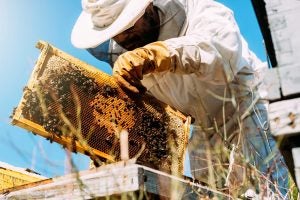Spring is the time of year when farms bloom into life as they emerge from winter hibernation (well, at least crop farms). Farmers take to their fields to plant the new crop, usually working long hours to get it all done. But they aren’t alone in those fields. As warmer weather returns, pollinators also emerge and get to their important work.
Everyone knows that bees are important for their pollinating activities. There are over 250,000 plant species that rely on bees to mix and spread nectar and pollen for reproductive purposes. The result is the wide array of foods that we enjoy, including some staples of our diets, like apples, melons, broccoli, and almonds. According to the Food and Drug Administration, the bees’ service accounts for $15 billion in added crop value.
And there’s also the things bees produce themselves: honey, pollen, royal jelly, beeswax, propolis, and venom. Humans harvest these items and have learned to use them for a variety of nutritional and medicinal purposes. The economic impact is also substantial. Honey bees produced 157 million pounds of honey in 2019 — that’s about $339 million worth!
» Related: 12 interesting facts about honey bees
Given everything bees contribute to our lives, it’s not surprising that the public’s interest in pollinators has increased over time. It certainly peaked with the mysterious Colony Collapse Disorder, which caused adult bees to leave the hive and never return. Beekeepers were also seeing higher-than-average losses in bee population over the winter. The two problems puzzled scientists, while the mystery inspired people to embrace actions that supported pollinator health. (And good news — the bees are doing just fine now!)

Unfortunately, as with so many things, activists used a genuine interest and concern for pollinators to push an agenda. Their boogeyman is neonicotinoids. The class of insecticides came onto the scene in the 1990s and are now the predominant class used in the United States, Europe, and Australia. They largely replaced older broad spectrum pesticides and require fewer applications, are safer for farmworkers, and can be used as seed treatments.
But being popular and safer for the environment doesn’t guarantee that environmental groups will warm to you, especially if you’re a dreaded pesticide. Armed with inconclusive research, they spread the narrative that neonics were killing bees and the continued use of them risked the future of all mankind. In other words, bee-pocalypse.
In other parts of the world, namely the European Union, such allegations were enough to cause outright bans on neonicotinoids, depriving farmers of an important crop protection tool.
Ironically, as I was researching for this article, I came across the Republic of Slovenia’s website heralding the benefits of pollinators and the risks they face. It boasts that “Slovenia restricted the use of neonicotinoids already in 2008, and the use thereof on crops that may have an impact on bees was finally banned in 2011.” The European Union didn’t implement its ban until 2018.
May. Have. Here’s your introduction to the ridiculous precautionary principle.
These hysterics didn’t sway the Environmental Protection Agency in the U.S. The EPA already has a robust regulatory framework for pesticides, including neonicotinoids. Farmers are required to follow the EPA’s label instructions for safe use. In 2022, the EPA released changes to neonicotinoid labels to reduce the chances bees would come into contact with the insecticide. As one entomologist told me, bees are insects and can die from insecticide exposure. But that doesn’t mean neonics are causing an extinction-level event.
Unfortunately, individual states aren’t always as rational and measured as the EPA. A number of states — including New York, Vermont, Massachusetts, and New Jersey — have passed legislation reclassifying neonicotinoids as restricted-use pesticides. That means only licensed applicators can use them, increasing costs and potentially making them inaccessible for some farmers.
Unfortunately, neonicotinoids are just the latest example of how an activist message can lead to new laws, regulations, and bans. Farmers obviously care about pollinators and bee health — they’re vital to what we do. But somehow the narrative was distorted to make it seem as though our crop-protection tools are the problem. It’s a reminder that we need to be vocal about issues and confront disinformation.
Amanda Zaluckyj blogs under the name The Farmer’s Daughter USA. Her goal is to promote farmers and tackle the misinformation swirling around the U.S. food industry.



